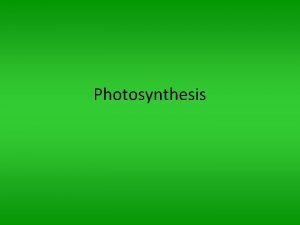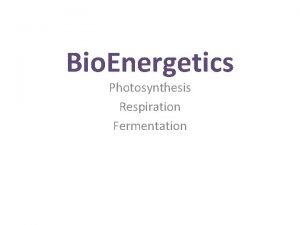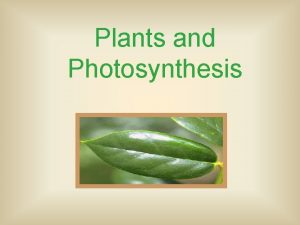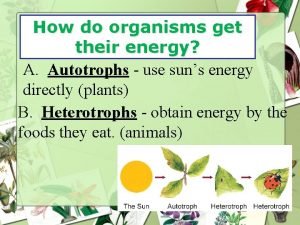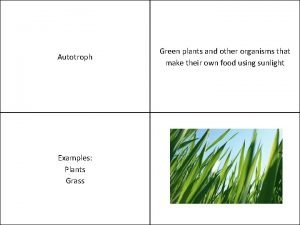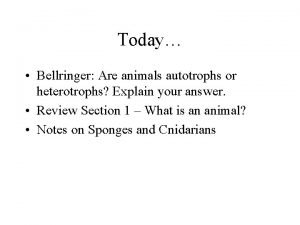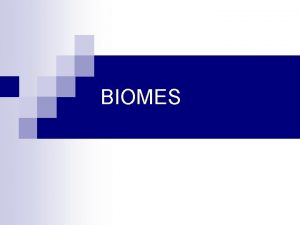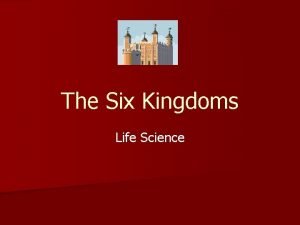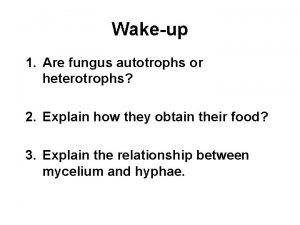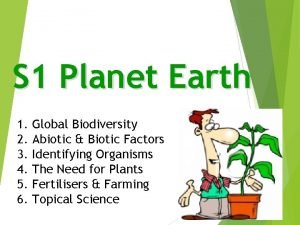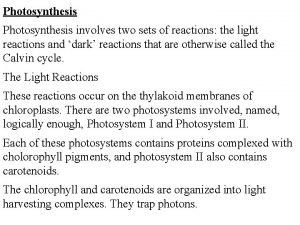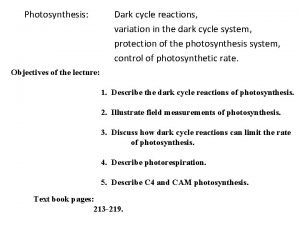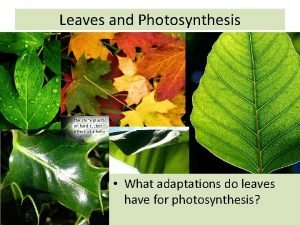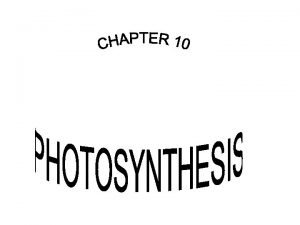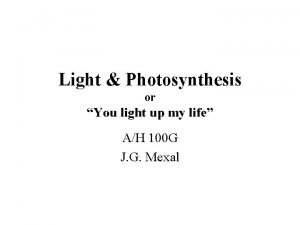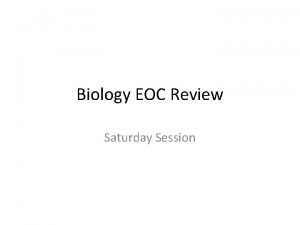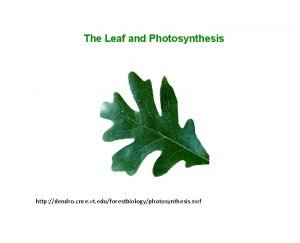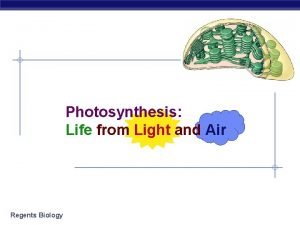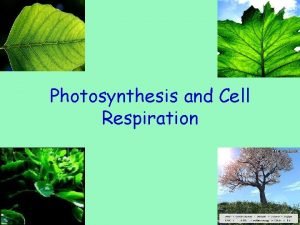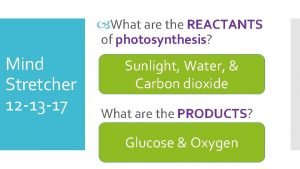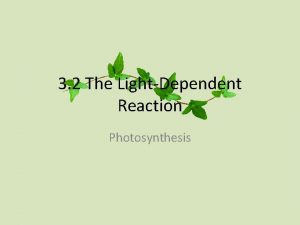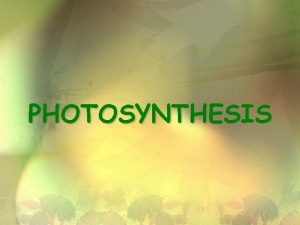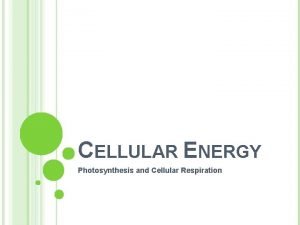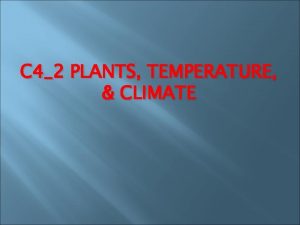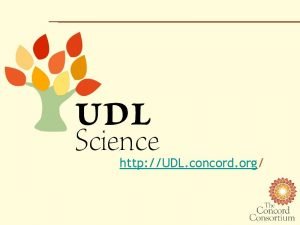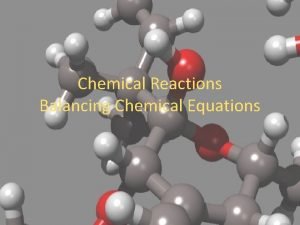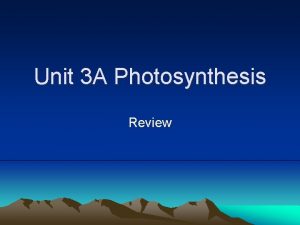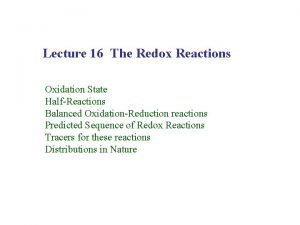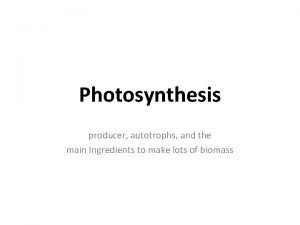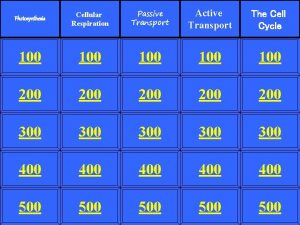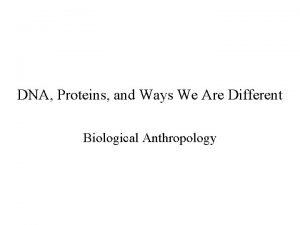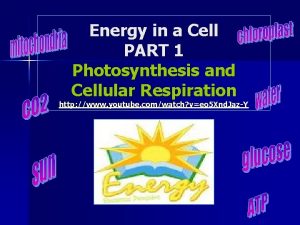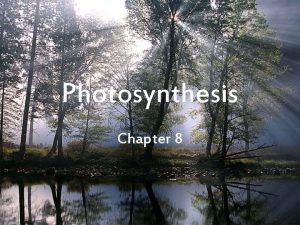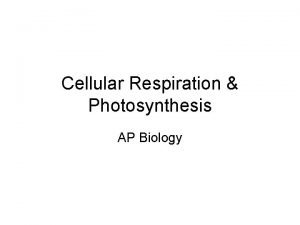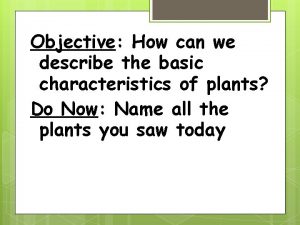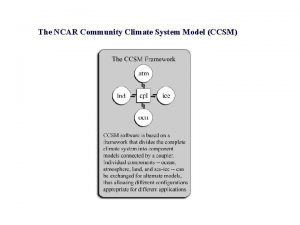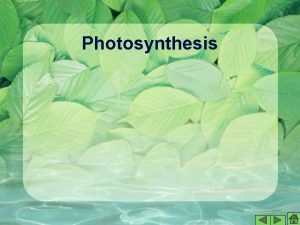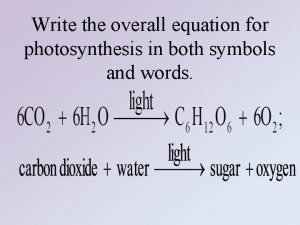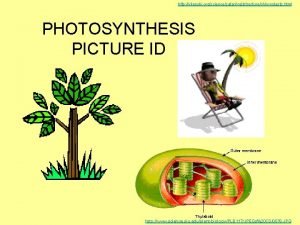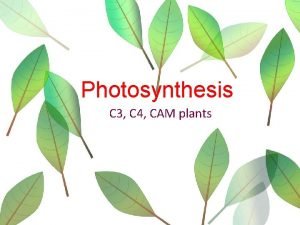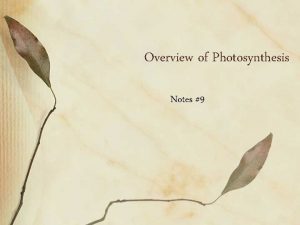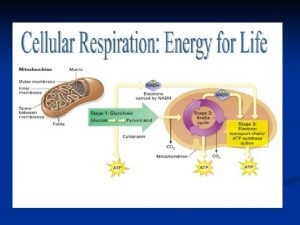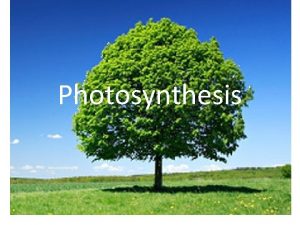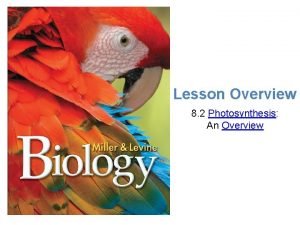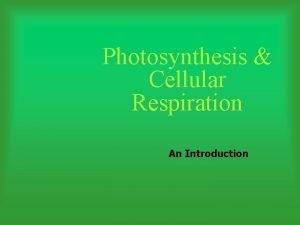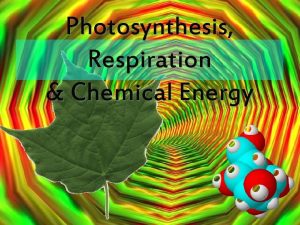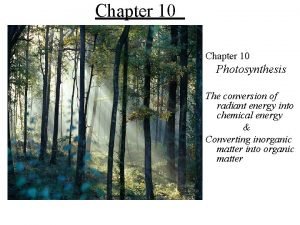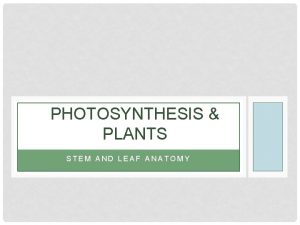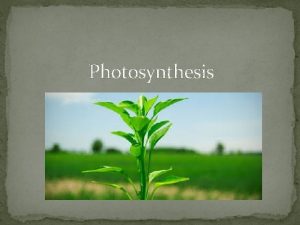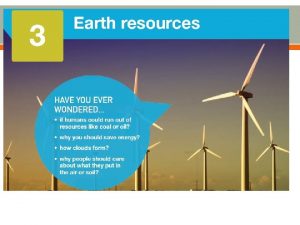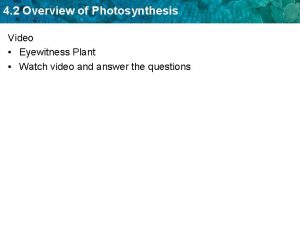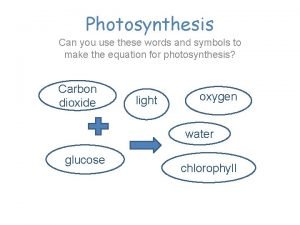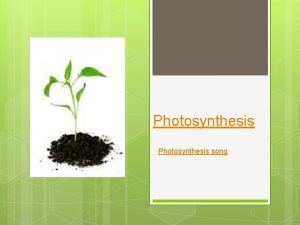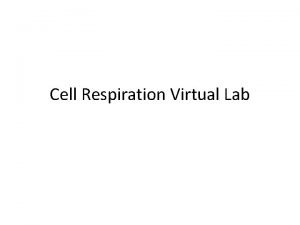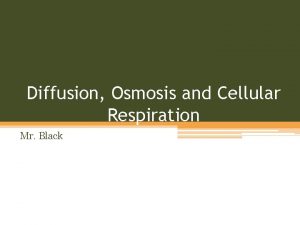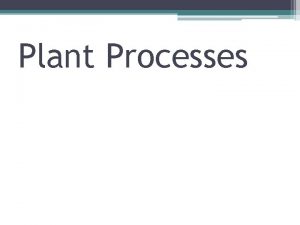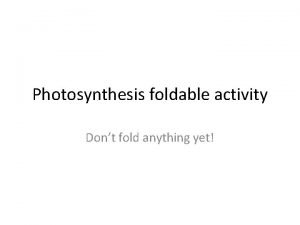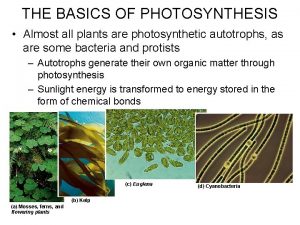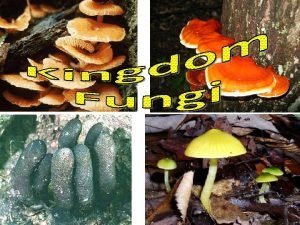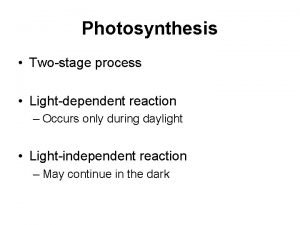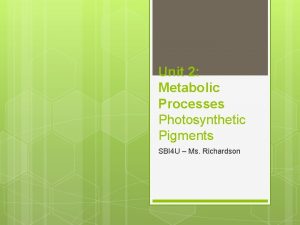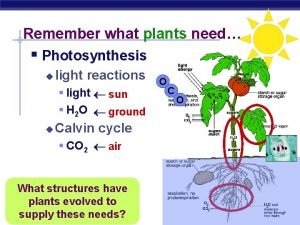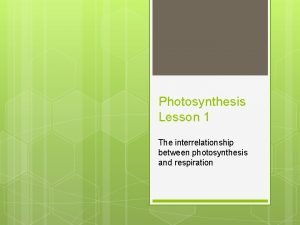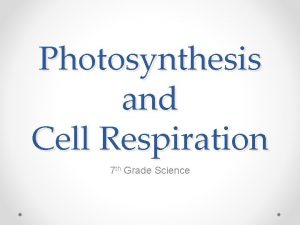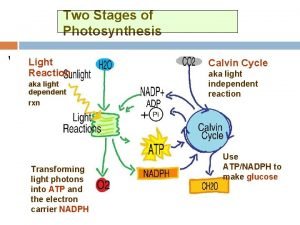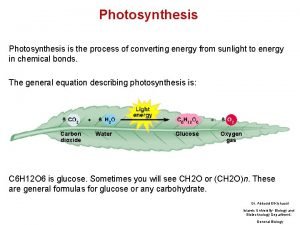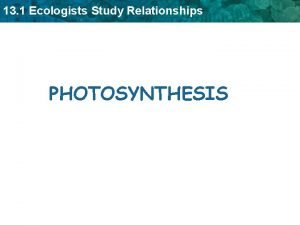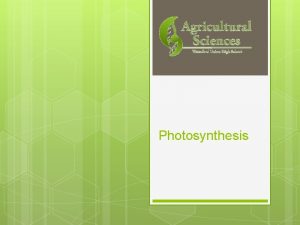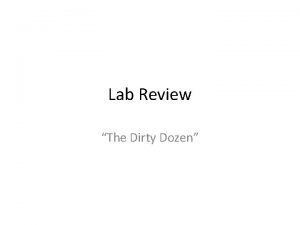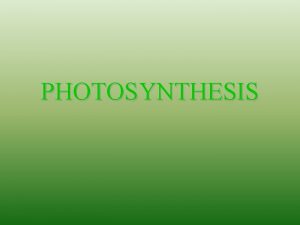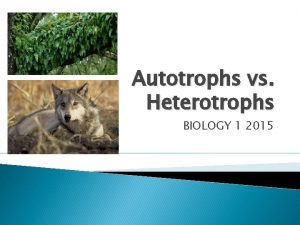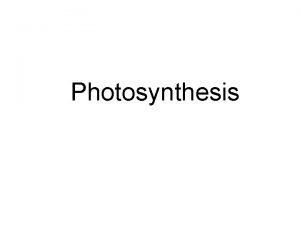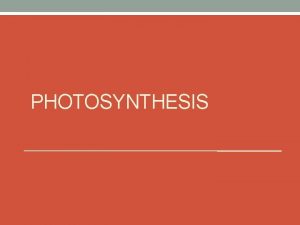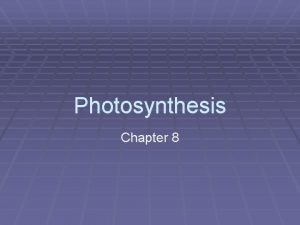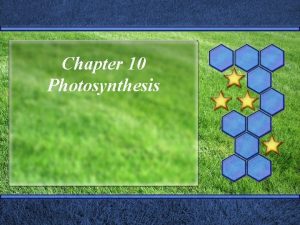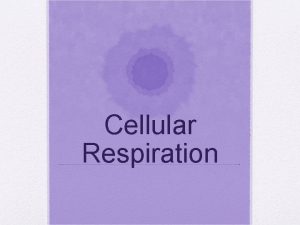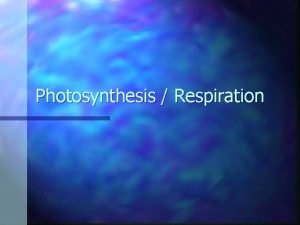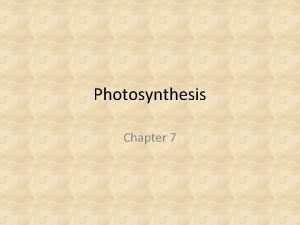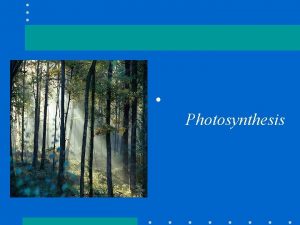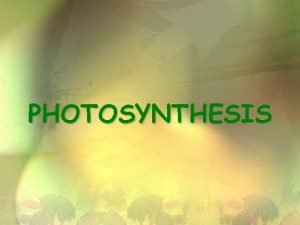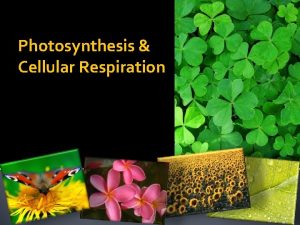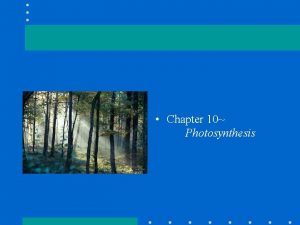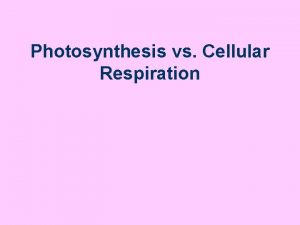Photosynthesis Juvekar K S Who are autotrophs Organisms



























































































- Slides: 91

Photosynthesis - Juvekar K. S.

Who are autotrophs? Organisms which prepare their own food are autotrophs. Organisms which prepare their own food are said to have autotrophic mode of nutrition. Autotrophs are of two types Photoautotrophs and Chemoautotrophs.

Who are photosynthetic autotrophs or photoautotrophs? Organisms which use solar energy/light energy to prepare their own food are photoautotrophs. They have photosynthetic pigments.

Examples of Photoautotrophs All plants

Examples of Photoautotrophs Protists like Diatoms

Examples of Photoautotrophs Prokaryotes like Cyanobacteria

Examples of Photoautotrophs Few bacteria like purple sulphur bacteria (Chromatium) and green sulphur bacteria (Chlorobium).

Who are chemosynthetic autotrophs or chemoautotrophs? Organisms which use energy released during chemical reactions to prepare their own food are chemoautotrophs. They do not have photosynthetic pigments.

Examples of Chemoautotrophs Bacteria such as nitrifying bacteria (Nitromonas), sulphur bacteria (Thiobacillus), iron bacteria (Ferrobacillus)

Photosynthesis: Prefix photo means: Light Root word synthesis means: To make Process in which plants use water and carbon dioxide in the presence of sunlight to make food (Glucose). • only occurs in the chloroplasts • releases oxygen

Overall equation of Photosynthesis Products of Photosynthesis

Glucose is the main product of Photosynthesis Most of it is used in respiration Extra is converted to starch and stored in plant body.

Do you know? When we burn wood, basically the photosynthesis formula is reversed. We're breaking down the carbohydrate and producing carbon dioxide gas and water, plus energy, which, like sunlight, feels hot and looks bright.

Leaves play major role in photosynthesis





Chloroplasts

Chloroplasts

Photosynthesis 1) Photosynthesis is a characteristic of Kingdom – Plantae 2) Plants make their own food by photosynthesis 3) They have chloroplasts Chloroplastsorganelle where photosynthesis takes place • they’re green because they have chlorophyll Chlorophyll- • the chemical that gives plants their green color • traps light energy for photosynthesis

Site of Photosynthesis 1 to 2

Site of Photosynthesis 4 to 6

Site of Photosynthesis um Inner i om r t is membrane r e P Outer membrane Grana Stroma

Site of Photosynthesis Inner membrane Grana Outer membrane Stroma Light Reactions Require light ATP synthesis takes place in Grana.

Site of Photosynthesis Inner membrane Grana Outer membrane Stroma (Dark Reaction/ Light Independent Reactions) Do not Require light CO 2 is reduced to form Glucose in Stroma.


Chlorophyll a. Mesophyll - molecule Photosystem Quantasome Thylakoids Chloroplast Grana Photoautotroph Palisade A leaf


Photosynthetic pigments Chlorophylls Carotenoids Phycobilins

Chlorophylls Photosynthetic pigments Chlorophyll a Chlorophyll b Chlorophyll c, d, e Bacteriochlorophyll Bacterioviridin Present in all photosynthetic organisms except Present in all greenphotosynthetic algae, bacteria. and all vascular plants. bryophytes Found in all brown and red algae Found in photosynthetic bacteria. along with Chlorophyll a. Blue green in in colour. Yellow green colour. C 55 55 H 70 72 O 65 N 44 Mg

Photosynthetic pigments Chlorophylls Carotenoids Phycobilins

Carotenoids Photosynthetic pigments Hydrocarbons with impirical formula C 40 H 56 Carotenes Xanthophylls The major carotene found in plants is carotene. Oxygenated hydrocarbons with impirical formula C 40 H 56 O 2. Major xanthophyll found in plants is Lutein.

Photosynthetic pigments Chlorophylls Carotenoids Phycobilins

Photosynthetic pigments Phycobilins Blue in colour. Found only in Cyanobacteria. Phycocyanins Phycoerythrins Red in colour. Found only in Red algae.

Photosynthetic pigments Carotenoids Xanthophylls Chlorophyll b Chlorophyll a

Photosynthetic pigments Photosynthesis is a photo-biochemical reaction. In higher plants, Chl. a, Chl. b, Carotenes and Xanthophylls are main photosynthetic pigmnets. Photosynthetic pigments absorb light of certain wavelength. The colour of the specific pigment indicates the wavelength of reflected light by that pigment.


Nature of Light Quantity (Intensity) of light influence photosynthesis. Quality (Wavelength) of light also influence photosynthesis.

…. . …. …. . . … … ……. . … During propagation light behaves as wave form. (Wave theory) When light interact with matter it behaves as a stream of discrete packets of energy known as photons. (Corpuscular theory)

Nature of Light The amount of energy in photon is called a Quantum. The pigments absorb the energy of quantum. The amount of energy present in photon is inversely proportional to the wavelength of light.

Nature of Light Wavelength ( ) of light is measured in nanometer(nm). 1 Nanometer = 1 x 10 -9 m

390 nm 760 nm

390 nm 760 nm

390 nm 760 nm

Photosynthesis - Visible Spectrum Color Violet Blue Green Yellow Red Far-Red Wavelength short Energy high long low

Photosystem

Measuring light absorption • A spectrometer is used to measure the amount of absorption at each wavelength • An action spectrum shows the rate of photosynthesis at different light intensities

Absorption of Light by Chlorophyll

Photosynthesis - PS Action Spectrum Color Violet Blue Green Yellow Red Far-Red Wavelength short Energy high Peak between 430 - 500 nm Peak at about 680 -700 nm long low

• Chlorophyll a and b absorb light mostly in the red and blue regions of the spectrum • Carotene and xanthophyll absorb light from other regions and pass the energy to chlorophyll a. • Accessory pigments do allow sunlight to fall on Chlorophyll a and prevent it from oxidation.




Brown seaweeds • subjected to low light intensities • Chlorophyll C instead of chlorophyll B • fucoxanthin -very wide absorption spectrum -absorbs light in parts of the spectrum where chlorophyll is less efficient

Red seaweeds • Have chlorophyll D • Phycoerythrin

Green seaweeds • Found in shallow water • Do not have fucoxanthin • Does not have phycoerythrin

Stages of Photosynthesis

The Energy-Capturing Reactions n Light absorption – Chlorophyll a and b are antennae pigments n Electron transport – Electrons lost by chlorophyll a end up at NADP – Produce oxygen n Chemiosmotic ATP synthesis – Powered by H ion reservoir

Photosynthesis - The Reactions Energy Transduction Rxns light dependent harvesting energy from the sun Carbon Fixation either light or dark requires energy from 1 st rxns fixes CO 2 into sugars Both occur in chloroplast

Photosynthesis - Energy Transduction Rxns Light dependent 2 photosystems, linkage pumps protons “purpose”: to generate ATP & NADPH

Photosynthesis - Carbon Fixation Rxns Dependent on energy “purpose”: to fix carbon, storing energy in bonds Calvin Cycle C 3 pathway 1 st product contains 3 carbons occurs in most plants

Photosynthesis - Photorespiration Rubisco affinity binds with both O 2 and CO 2 when it binds with O 2, carbon is bound into other products energy must be used to salvage the C rubisco contains nitrogen which is commonly the limiting nutrient

The Dark Reactions • The dark reactions take place outside thylakoid membrane. • Carbon fixation - The carbon dioxide is incorporated into an organic molecule (1 C + 5 C = 6 C). This 6 carbon structure is unstable and immediately splits into 2, 3 carbon molecules. These molecules go through a series of reactions known as the CALVIN CYCLE.

Photosynthesis - C 4 Pathway “Warm season” plants many native prairie grasses 1 st product contains 4 carbons use BOTH C 3 and C 4 pathways C fixed by PEP carboxylase in mesophyll prefers CO 2 over O 2 handles photorespiration problems product is shipped to bundle sheath cells Kranz anatomy the key to the C 4 pathway: spatial separation

C 4 and C 3 Pathways - Differences in Anatomy C - Kranz Anatomy C 4 3 CO 2 H 2 O and CO 2 pass through stomatal openings

Photosynthesis - CAM Pathway Succulent plants (like cacti) Crassulacean acid metabolism (CAM) use BOTH C 3 and C 4 pathways C fixed by PEP carboxylase in DARK allows plants to close stomata product is used in same cells must have HUGE vacuoles to store C the key to the CAM pathway: temporal separation allows internal cycling during drought pineapple is CAM

C 4 and C 3 Pathways - Differences in Anatomy C 4 - Kranz Anatomy CO 2 H 2 O C 3 H 2 O CO 2 H 2 O and CO 2 pass through stomatal openings

For a given growth rate, C 3 species use almost twice as much water as C 4 species. (i. e. , they have lower water use efficiencies (WUE) 50 14. 0 Transpiration both types 40 C 4 C 3 30 11. 2 8. 4 20 5. 6 10 2. 8 0 0 0 160 320 480 640 Leaf Conductance (mmol m-2 s-1) Transpiration (mmol m-2 s-1) Net Photosynthesis (µmol m-2 s-1) Photosynthesis - C 4 and C 3 Pathways

C 4 and C 3 Pathways - Light Saturation C 3 species become light saturated more quickly Carbon Gain provides advantage in low light environments C 4 C 3 Light

C 4 and C 3 Pathways - Effect of Temperature Net Photosynthesis (µmol m-2 s-1) 60 330 ppm 50 1000 ppm C 4 40 30 C 3 20 C 4 C 3 10 0 0 20 30 40 50 0 20 Leaf Temperature (°C) 30 40 50

C 4 and C 3 Pathways - Photorespiration Net Photosynthesis (µmol m-2 s-1) Conflict between CO 2 and O 2 places C 3 species at a disadvantage C 4 species are able to concentrate CO 2 providing an advantage under low CO 2 conditions 60 C 3, Low [O 2] C 3 Ambient [O 2] 50 40 C 4, Ambient [O 2] 30 20 10 0 -10 0 100 200 300 400 500 Intercellular [CO 2] (ppm) 600

Global Change - CO 2, N and Diversity Global N Fixation CO 2 Concentration “Natural” Anthropogenic 1920 Year 1980 0 Diversity Time Year 2000

C 4 and C 3 Pathways - Effect of CO 2 concentration Low CO 2: C 4 advantage due to concentrating of CO 2 Ambient CO 2: net growth about equal but water use is greater in C 3 60 Net Photosynthesis (µmol m-2 s-1) Competitive advantage between C 3 and C 4 switches along CO 2 gradient 50 C 4 40 30 700 ppm CO 2 20 200 ppm CO 2 350 ppm CO 2 10 0 High CO 2: C 3 advantage due to C 4’s low CO 2 -10 saturation point and reduction of CO 2 / O 2 conflict in C 3 0 100 200 300 400 500 Intercellular CO 2 (ppm) 600

Overview of photosynthesis and respiration SUN RADIANT ENERGY PHOTOSYNTHESIS GLUCOSE RESPIRATION CELL ACTIVITIES ATP(ENERGY)

EQUATION FOR PHOTOSYNTHESIS WATER 6 CO 2 + 6 H 2 O + ENERGY CARBON DIOXIDE OXYGEN C 6 H 12 O 6 + GLUCOSE 6 O 2




Ecological Aspects • C 4 PLANTS - Use more ATP but at high temperatures they can photosynthesize faster allowing plants to grow and reproduce faster. These include many weeds and important crops such as corn. • A special variation of C 4 plants are the CAM plants. These are mostly desert plants. These plants keep the stomata closed during the day and open at night. They must conserve water!











 Insidan region jh
Insidan region jh Organism
Organism Why do organisms interact with other organisms
Why do organisms interact with other organisms Autotrophs
Autotrophs Difference between autotroph and heterotroph
Difference between autotroph and heterotroph Granum
Granum Are mosses autotrophs
Are mosses autotrophs Grass autotroph
Grass autotroph Protists can be autotrophs. true false
Protists can be autotrophs. true false Are cnidarians autotrophs or heterotrophs
Are cnidarians autotrophs or heterotrophs Is eubacteria terrestrial or aquatic
Is eubacteria terrestrial or aquatic Are fungi autotrophs
Are fungi autotrophs Archaebacteria body type
Archaebacteria body type Burrowing owl food chain
Burrowing owl food chain How living things obtain energy worksheet answers
How living things obtain energy worksheet answers Are fungi autotrophs
Are fungi autotrophs Photosynthesis chlorophyll
Photosynthesis chlorophyll What are the 2 sets of reactions in photosynthesis
What are the 2 sets of reactions in photosynthesis Word equation for photosynthesis
Word equation for photosynthesis Dark cycle photosynthesis
Dark cycle photosynthesis Adaptations of leaf for photosynthesis
Adaptations of leaf for photosynthesis Light reaction of photosynthesis
Light reaction of photosynthesis Photosynthesis c4
Photosynthesis c4 First stage of photosynthesis
First stage of photosynthesis Photosynthesis carbon dioxide
Photosynthesis carbon dioxide Dendro.cnre.vt.edu photosynthesis
Dendro.cnre.vt.edu photosynthesis Leaf diagram photosynthesis
Leaf diagram photosynthesis Respiration
Respiration Reactants of photosynthesis
Reactants of photosynthesis Bozeman photosynthesis lab
Bozeman photosynthesis lab Light dependent reactions steps
Light dependent reactions steps Photosynthesis anabolic
Photosynthesis anabolic Formula for photosynthesis and cellular respiration
Formula for photosynthesis and cellular respiration Relative rate of photosynthesis
Relative rate of photosynthesis Concord consortium molecular workbench photosynthesis
Concord consortium molecular workbench photosynthesis Summary equation for cellular respiration
Summary equation for cellular respiration Balanced chemical equation for photosynthesis
Balanced chemical equation for photosynthesis Which of the following equations represents photosynthesis
Which of the following equations represents photosynthesis Oxidation half reaction
Oxidation half reaction Ingredients of photosynthesis
Ingredients of photosynthesis Is photosynthesis active or passive transport
Is photosynthesis active or passive transport Photosynthesis
Photosynthesis Photosynthesis energy transformation
Photosynthesis energy transformation Section 8-2 photosynthesis
Section 8-2 photosynthesis Paramecium eyespot
Paramecium eyespot Photosynthesis citric acid cycle
Photosynthesis citric acid cycle Leaf diagram photosynthesis
Leaf diagram photosynthesis Photosynthesis model
Photosynthesis model Photosynthesis concept map answer key
Photosynthesis concept map answer key Write the overall equation for photosynthesis
Write the overall equation for photosynthesis Products of photosynthesis
Products of photosynthesis Cam plant
Cam plant Photosynthesis reactants
Photosynthesis reactants What is the opposite of photosynthesis
What is the opposite of photosynthesis Is photosynthesis a redox reaction
Is photosynthesis a redox reaction Photosynthesis requires
Photosynthesis requires Photosynthesis
Photosynthesis Products of photosynthesis
Products of photosynthesis Photosynthesis and cellular respiration
Photosynthesis and cellular respiration Is transpiration endothermic or exothermic
Is transpiration endothermic or exothermic Two major steps of photosynthesis
Two major steps of photosynthesis Photosynthesis protists
Photosynthesis protists Monocot คือ
Monocot คือ Chemiosmosis in photosynthesis
Chemiosmosis in photosynthesis Worded equation for photosynthesis
Worded equation for photosynthesis Photosynthesis
Photosynthesis Photosynthesis equation in words and symbols
Photosynthesis equation in words and symbols Chapter 9 lesson 2 photosynthesis an overview
Chapter 9 lesson 2 photosynthesis an overview Photosynthesis song
Photosynthesis song Cell respiration virtual lab
Cell respiration virtual lab The warm up osmosis
The warm up osmosis Photosynthesis
Photosynthesis Photosynthesis foldable
Photosynthesis foldable Inputs of light reactions in photosynthesis
Inputs of light reactions in photosynthesis Photosynthesis transforms light energy into chemical energy
Photosynthesis transforms light energy into chemical energy Fungi photosynthesis
Fungi photosynthesis Galp photosynthesis
Galp photosynthesis Green plants make their own food by photosynthesis
Green plants make their own food by photosynthesis Reactants of photosynthesis
Reactants of photosynthesis Site of photosynthesis
Site of photosynthesis How to remember photosynthesis
How to remember photosynthesis Interrelationship between photosynthesis and respiration
Interrelationship between photosynthesis and respiration Respiration chemical equation
Respiration chemical equation Two stages of photosynthesis
Two stages of photosynthesis Photosynthesis is the process of converting
Photosynthesis is the process of converting Photosynthesis comic
Photosynthesis comic Photosynthesis in a nutshell
Photosynthesis in a nutshell Photosynthesis is important to animals because flocabulary
Photosynthesis is important to animals because flocabulary Essay on photosynthesis
Essay on photosynthesis Photosynthesis cake
Photosynthesis cake Process of photosynthesis equation
Process of photosynthesis equation Methane oxygen reaction
Methane oxygen reaction



